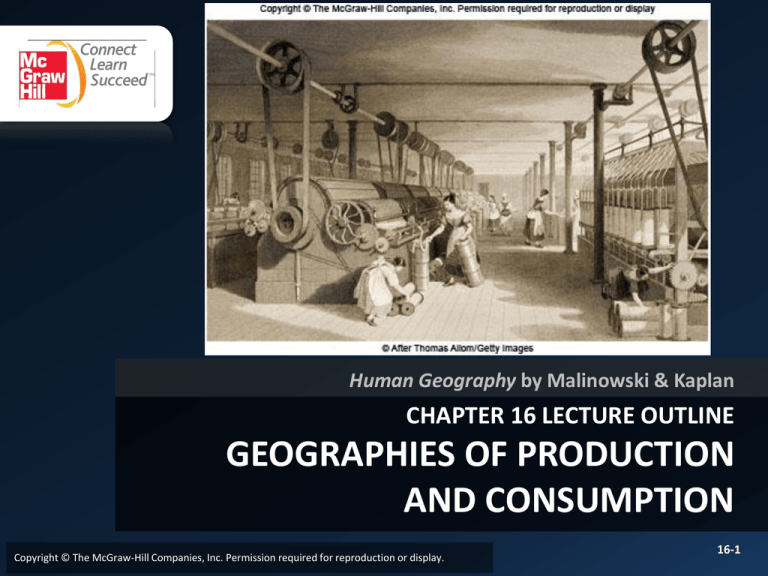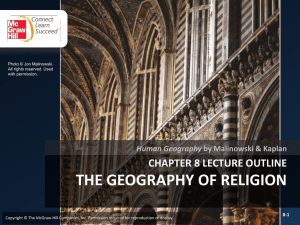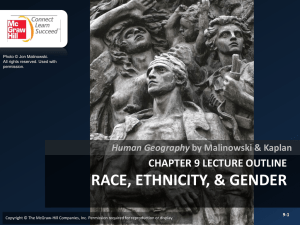Chapter 16 - Miami Beach Senior High School
advertisement

Human Geography by Malinowski & Kaplan CHAPTER 16 LECTURE OUTLINE GEOGRAPHIES OF PRODUCTION AND CONSUMPTION Copyright © The McGraw-Hill Companies, Inc. Permission required for reproduction or display. 16-1 Chapter 16 Modules • 16A Growth of Mass Production and an Industrial World • 16B Factors of Production and Changing Geographies of Industrial Location • 16C Industrialization and the Early Development of the US Space Economy • 16D Modern Shifts in US Manufacturing • 16E The Geography of High Technology • 16F Globalized Manufacturing and the Rise of Transnational Corporations • 16G Geographies of Consumption • 16H Consuming Places: Geographies of Tourism Copyright © The McGraw-Hill Companies, Inc. Permission required for reproduction or display. 16-2 16A: Growth of Mass Production • Production adds value greater than the sum of the raw materials used, hence value added • Mass production was the key outcome of industrialization • As the quantity of goods rose, prices dropped • The factory system emerged because large, expensive machines required a great deal of money to buy and operate • Factories led to a division of labor where workers specialized in single, repeated tasks Copyright © The McGraw-Hill Companies, Inc. Permission required for reproduction or display. 16-3 19th Century Factory Copyright © The McGraw-Hill Companies, Inc. Permission required for reproduction or display. Figure 16A.1 16-4 Industry in Great Britain 1715-1815 Copyright © The McGraw-Hill Companies, Inc. Permission required for reproduction or display. Figure 16A.2 16-5 The Spread of Industrialization Copyright © The McGraw-Hill Companies, Inc. Permission required for reproduction or display. Figure 16A.3 16-6 16B: Factors of Production and Changing Geographies of Industrial Location 1 • A production chain transforms raw materials into a finished product • The process incorporates a number of direct and indirect factors of production Copyright © The McGraw-Hill Companies, Inc. Permission required for reproduction or display. 16-7 16B: Direct & Indirect Factors of Production DIRECT FACTORS INDIRECT FACTORS • • • • • • • • • • Raw materials Labor Financial capital Markets Technology Infrastructure Financial system Government role Education / training Entrepreneurial climate Copyright © The McGraw-Hill Companies, Inc. Permission required for reproduction or display. 16-8 16B: Factors of Production and Changing Geographies of Industrial Location 2 • Alfred Weber’s model of industrial location • The optimum location of a manufacturing plant is a balance between the locations of raw materials, the labor force, and the markets where the products are sold • Products that lose weight in production are better situated near the raw materials • Products that gain weight in production, such as the adding of water, are better situated near the market Copyright © The McGraw-Hill Companies, Inc. Permission required for reproduction or display. 16-9 Weber’s Model Copyright © The McGraw-Hill Companies, Inc. Permission required for reproduction or display. Figure 16B.1 16-10 16B: Factors of Production and Changing Geographies of Industrial Location 3 Changes in recent decades have affected industrial location: 1. Transportation costs have declined 2. Labor costs and specialization of labor have increased 3. A lot of production is now conducted overseas 4. Government plays a bigger role in trying to lure businesses to certain areas 5. Production processes are more flexible and nimble because of computers, robots, fast shipping of raw materials, etc.. Copyright © The McGraw-Hill Companies, Inc. Permission required for reproduction or display. 16-11 16C: Industrialization and the Early Development of the US Space Economy • The U.S. started industrializing later than some places in Europe • By 1790 textile mills were in Rhode Island and then across southern New England by the 1830s • By 1860, 72% of all manufacturing was in the Northeast • Diversification through forward linkages and backward linkages Copyright © The McGraw-Hill Companies, Inc. Permission required for reproduction or display. 16-12 Late 19th Century Industry Copyright © The McGraw-Hill Companies, Inc. Permission required for reproduction or display. Figure 16C.3 16-13 Geographic Advantages of the AngloAmerican Manufacturing Belt • Good railroad network to tie the region together • Close proximity between places • Close to main banks • Good ports, good farmland, abundant coal • The region attracted skilled and unskilled labor Copyright © The McGraw-Hill Companies, Inc. Permission required for reproduction or display. 16-14 16D: Modern Shifts in US Manufacturing 1 • After the middle of the 20th century, a shift to the South and West • A move from inner cities to outer suburbs • The move of high-paying jobs hurt losing areas – Base employment supports numerous service sector jobs [multiplier effect] Copyright © The McGraw-Hill Companies, Inc. Permission required for reproduction or display. 16-15 Base Employment Copyright © The McGraw-Hill Companies, Inc. Permission required for reproduction or display. Figure 16D.2 16-16 16D: Modern Shifts in US Manufacturing 2 Causes for the shift to the South and West: 1. Cheaper labor costs in the South 2. Increased car use and trucking, & better highways, made the railroads of the Northeast less important 3. Increased need for oil and gas made places like Texas more important for businesses 4. New, high-tech sectors sprung up in areas outside of the Northeast, or moved there 5. Government programs helped develop nonNortheast areas Copyright © The McGraw-Hill Companies, Inc. Permission required for reproduction or display. 16-17 16E: The Geography of High Technology 1 • High-technology firms have emerged recently and have made certain areas more important • Geographic factors for high-tech firms include: – Proximity to major universities – An entrepreneurial climate with venture capitalists – Environmental amenities to attract skilled labor – Good transportation and communication networks Copyright © The McGraw-Hill Companies, Inc. Permission required for reproduction or display. 16-18 Global High-Tech Centers, 2000 Copyright © The McGraw-Hill Companies, Inc. Permission required for reproduction or display. Figure 16E.1 16-19 16E: The Geography of High Technology 2 • High-technology clusters share: – Specialized labor – Specialized inputs: specific technologies, specialized equipment, etc. – Knowledge spillovers from formal and informal channels, and from universities – Accessibility to markets or users Copyright © The McGraw-Hill Companies, Inc. Permission required for reproduction or display. 16-20 16F: Globalized Manufacturing and the Rise of Transnational Corporations 1 • Globalization – The elimination of national boundaries through ever greater integration of people, companies, and governments across the world • Characteristics of globalization include: – Deterritorialization – More social and economic interconnectedness – Faster communications – A multipronged process including political, social, cultural, and economic movements Copyright © The McGraw-Hill Companies, Inc. Permission required for reproduction or display. 16-21 Global Colonial & Trade Activity Figure 16F.1 1500-1800 Copyright © The McGraw-Hill Companies, Inc. Permission required for reproduction or display. 16-22 Stages of Globalization Copyright © The McGraw-Hill Companies, Inc. Permission required for reproduction or display. Table 16F.1 16-23 16F: Globalized Manufacturing and the Rise of Transnational Corporations 2 • A multidivisional corporation is a company with many division based on product lines • A transnational corporation (TNC) is a multidivisional corporation that has overseas divisions Copyright © The McGraw-Hill Companies, Inc. Permission required for reproduction or display. 16-24 Location of Bayer’s Branch Plants Copyright © The McGraw-Hill Companies, Inc. Permission required for reproduction or display. Figure 16F.3 16-25 Toyota Plants in the US Copyright © The McGraw-Hill Companies, Inc. Permission required for reproduction or display. Figure 16F.4 16-26 Corporations by Country Copyright © The McGraw-Hill Companies, Inc. Permission required for reproduction or display. Figure 16F.5 16-27 Global Production Lines Copyright © The McGraw-Hill Companies, Inc. Permission required for reproduction or display. Figure 16F.7 16-28 16G: Geographies of Consumption • Consumption is interlinked with production • Mass consumption means more and more people are consuming “luxuries” • Conspicuous consumption • people feel a need to display their status by ostentatiously consuming goods and services • Commodity chains: – Design, Production, Marketing, Retail Copyright © The McGraw-Hill Companies, Inc. Permission required for reproduction or display. 16-29 16H: Consuming Places: Geographies of Tourism Figure 16H.2 Copyright © The McGraw-Hill Companies, Inc. Permission required for reproduction or display. 16-30







